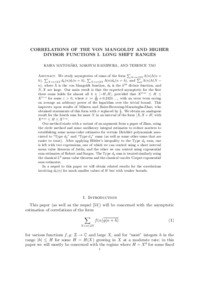Correlations of the von Mangoldt and higher divisor functions I. Long shift ranges
Kaisa Matomäki; Maksym Radziwiłł; Terence Tao
https://urn.fi/URN:NBN:fi-fe2021042719661
Tiivistelmä
We study asymptotics of sums of the form ∑ X < n ⩽ 2 X Λ ( n ) Λ ( n + h ) , ∑ X < n ⩽ 2 X d k ( n ) d l ( n + h ) , ∑ X < n ⩽ 2 X Λ ( n ) d k ( n + h ) , and ∑ n Λ ( n ) Λ ( N − n ) , where Λ is the von Mangoldt function, d k is the k th divisor function, and N , X are large. Our main result is that the expected asymptotic for the first three sums holds for almost all h ∈ [ − H , H ] , provided that X σ + ε ⩽ H ⩽ X 1 − ε for some ε > 0 , where σ : = 8 33 = 0.2424 ⋯ , with an error term saving on average an arbitrary power of the logarithm over the trivial bound. This improves upon results of Mikawa and Baier–Browning–Marasingha–Zhao, who obtained statements of this form with σ replaced by 1 3 . We obtain an analogous result for the fourth sum for most N in an interval of the form [ X , X + H ] with X σ + ε ⩽ H ⩽ X 1 − ε .
Our method starts with a variant of an argument from a paper of Zhan, using the circle method and some oscillatory integral estimates to reduce matters to establishing some mean‐value estimates for certain Dirichlet polynomials associated to ‘Type d 3 ’ and ‘Type d 4 ’ sums (as well as some other sums that are easier to treat). After applying Hölder's inequality to the Type d 3 sum, one is left with two expressions, one of which we can control using a short interval mean value theorem of Jutila, and the other we can control using exponential sum estimates of Robert and Sargos. The Type d 4 sum is treated similarly using the classical L 2 mean value theorem and the classical van der Corput exponential sum estimates.
In a sequel to this paper we will obtain related results for the correlations involving d k ( n ) for much smaller values of H but with weaker bounds.
Kokoelmat
- Rinnakkaistallenteet [27094]
